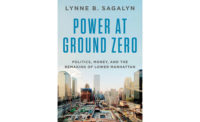On a rainy evening last week, the St. Nicholas Greek Orthodox Church and National Shrine, a miniature Hagia Sophia that glows from within like a child’s nightlight topped by a golden cross, loomed over the World Trade Center’s memorial fountains. But is this new building—one of the last projects to be completed on the 16 acres of Ground Zero—a comforting sight or a troubling intrusion of religion into a secular venue?
St. Nicholas’s previous home, in a former tavern across the street from the Trade Center’s south tower, was destroyed when that tower collapsed on September 11, 2001. The Port Authority of New York and New Jersey, which owns and operates the Center, offered to buy the lot the church had stood on, which it needed for underground vehicle access to the reconfigured complex, for $20 million and a promise to help build a church in a comparable location.
--Alan-Karchmer-for-Santiago-Calatrava_result2.webp)
Photo © Alan Karchmer for Santiago Calatrava
Santiago Calatrava, the architect of the new church, remembers that even before he was chosen to design it, “there was a discussion if a religious building should be put there or not. It went on and on.” But it was moot, he says, because there was no place for the building. And then, he declares, “a miracle happened.” What miracle? “They realized they could put it over the truck entrance,” quite close to the old site but raised up at least 25 feet.
Greek Orthodox leaders now had a chance to replace a church that served fewer than 100 families before 9/11 with a “national shrine” on a site that attracts hundreds of thousands of visitors a year. But progress was slow, and in 2011 the church sued the Port Authority, claiming it hadn’t made rebuilding St. Nicholas a high enough priority. In a settlement later that year, the Port Authority agreed to rent the church the elevated site for 198 years at $1 a year, and to prepare the plinth for construction. The church agreed that its new building would include a non-denominational bereavement center.
Enter Calatrava, chosen from about a dozen architects in an invited competition. “I thought I had no chance to win, because I was already doing the other building on the site,” he says, referring to the $4 billion transportation/retail hub known as the Oculus. “I knew little about the Greek Orthodox church,” he adds, “but I had worked for the Olympics in Athens. And I was familiar with the Hagia Sophia and consider it one of the most beautiful spaces in the history of architecture.”
Calatrava devised a small building with a large presence. Its simple shape—a hemispheric dome bounded by four square towers—seems comforting, familiar. In fact, it is a shrunken version of the Hagia Sophia, Istanbul’s former Greek Orthodox cathedral, which became a mosque 600 years ago. Ingeniously, the architect proposed making this church’s dome out of thin sheets of pentelic marble (the Greek marble used for the Parthenon), which, backlit by LEDs, would glow at night like a very large bauble.
But fundraising shortfalls, cost overruns and behind-the-scenes disputes delayed construction.
The church, on which the archdiocese spent $58 million and the Port Authority spent tens of millions more, was finally christened last week, more than 21 years after the attacks. It is only 65 feet tall, but with its pristine, detail-free shell, seemingly levitating over the site, it gives little sense of its actual size. “It is scaleless,” Calatrava says. “It’s like a magic thing, an abstract thing, like a large sculpture.”
In most Calatrava buildings, the crisp folds of bright-white surfaces and the repetition of structural elements are the only ornamentation. Some of that engineering prowess is on display inside the church. Yet much of its interior is covered in interpretations of 14th century hagiographic art, as painted by a monk on Mt. Athos, Greece. One prominent mural depicts the Virgin Mary holding lower Manhattan—including the church itself—in her protective embrace. Asked whether the church added more paintings than Calatrava’s early renderings seemed to call for, Matthew Constantino, a spokesman for Calatrava's office, said: “Mr. Calatrava was strictly involved in the architectural and design elements of the church. The iconography decisions were handled by the Greek Orthodox Church.”
Photo © Alan Karchmer for Santiago Calatrava
Calatrava insists his glowing building is ecumenical. “It’s a candle, and everyone lights candles. Not just the Greek Orthodox,” he says.
As for the bereavement center called for in the 2011 agreement, the spokesman wrote in an email that it “is currently on the second floor of the Church. However, this is still in flux and could potentially be moved off-site.”
In 2010, there was an outcry over a proposed Islamic Cultural Center that wasn’t even visible from the trade center site but was nonetheless dubbed the Ground Zero Mosque. The Greek Orthodox shrine, on World Trade Center land, made its debut in a ceremony filled with unabashedly religious language.
Says Calatrava, “It is a religious building; that is the reality.” But then he seems to pivot: “My own opinion is that the building is very ecumenical. I think there are people with different beliefs, and many non-believers, who suffer because they lost people in the tragedy, and this building is for all of them.”
St. Nicholas Greek Orthodox Church Construction Timelapse. Video © EarthCam

--Alan-Karchmer-for-Santiago-Calatrava_result2.webp?t=1670962171&width=1080)
--Alan-Karchmer-for-Santiago-Calatrava_result2.webp?t=1670962178&width=1080)
--Alan-Karchmer-for-Santiago-Calatrava_result2.webp?t=1670962188&width=1080)


Post a comment to this article
Report Abusive Comment